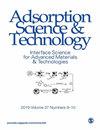Adsorption of Hydrogen Sulfide on Reduced Graphene Oxide-Wrapped Titanium Dioxide Nanofibers
IF 3.2
4区 工程技术
Q2 CHEMISTRY, APPLIED
引用次数: 0
Abstract
This work presents a fabrication of room-temperature gas sensor for hydrogen sulfide (H2S) adsorption. Pristine titanium dioxide (TiO2) nanofibers, reduced graphene oxide (rGO) sheets, and reduced graphene oxide-wrapped titanium dioxide (rGO-wrapped TiO2) nanofibers were presented in the form of integrated suspension used for a gas-sensing layer. The TiO2 nanofibers were firstly synthesized by using an electrospinning method with a polyvinylpyrrolidone (PVP) polymer. The rGO sheets were then wrapped around TiO2 nanofibers by a hydrothermal method. Scanning electron microscope, transmission electron microscope, X-ray diffractometer, and Raman spectrometer confirmed the presence of rGO sheets onto the surface of TiO2 nanofibers. Ultraviolet-visible spectrophotometer was also considered and displayed to calculate the band gap of TiO2 and rGO-wrapped TiO2 nanofibers. After preparing the gas-sensing suspensions, they were dropped onto the polyethylene terephthalate substrates with silver-interdigitated electrodes. The gas-sensing properties of sensors were evaluated for H2S adsorption at room temperature. Based on the results, the rGO-wrapped TiO2 nanofiber gas sensor exhibited higher H2S sensitivity and selectivity than pristine TiO2 nanofiber and pure rGO gas sensors. The H2S-sensing mechanism of rGO-wrapped TiO2 nanofiber gas sensor was discussed based on a formation of p-n heterojunctions between p-type rGO sheets and n-type TiO2 nanofibers. Furthermore, a direct charge-transfer process by physisorption was also highlighted as a second H2S-sensing mechanism.还原氧化石墨烯包裹二氧化钛纳米纤维对硫化氢的吸附
本文介绍了一种用于硫化氢(H2S)吸附的室温气体传感器。原始二氧化钛(TiO2)纳米纤维、还原氧化石墨烯(rGO)薄片和还原氧化石墨烯包裹二氧化钛(rGO包裹TiO2)纳米纤维以集成悬浮液的形式呈现,用于气敏层。以聚乙烯吡咯烷酮(PVP)聚合物为原料,采用静电纺丝法制备了TiO2纳米纤维。然后用水热法将氧化石墨烯薄片包裹在TiO2纳米纤维上。扫描电子显微镜、透射电子显微镜、x射线衍射仪和拉曼光谱仪证实TiO2纳米纤维表面存在氧化石墨烯片。利用紫外可见分光光度计计算TiO2和rgo包覆TiO2纳米纤维的带隙。制备完气敏悬浮液后,将其用银交叉电极滴在聚对苯二甲酸乙二醇酯衬底上。评价了传感器在室温下吸附H2S的气敏性能。结果表明,rGO包裹的TiO2纳米纤维气体传感器比原始TiO2纳米纤维和纯rGO气体传感器具有更高的H2S灵敏度和选择性。基于p型rGO薄膜与n型TiO2纳米纤维之间形成的p-n异质结,探讨了rGO包覆TiO2纳米纤维气体传感器的h2s传感机理。此外,通过物理吸附的直接电荷转移过程也被强调为第二种h2s传感机制。
本文章由计算机程序翻译,如有差异,请以英文原文为准。
求助全文
约1分钟内获得全文
求助全文
来源期刊

Adsorption Science & Technology
工程技术-工程:化工
CiteScore
5.00
自引率
10.30%
发文量
181
审稿时长
4.5 months
期刊介绍:
Adsorption Science & Technology is a peer-reviewed, open access journal devoted to studies of adsorption and desorption phenomena, which publishes original research papers and critical review articles, with occasional special issues relating to particular topics and symposia.
 求助内容:
求助内容: 应助结果提醒方式:
应助结果提醒方式:


